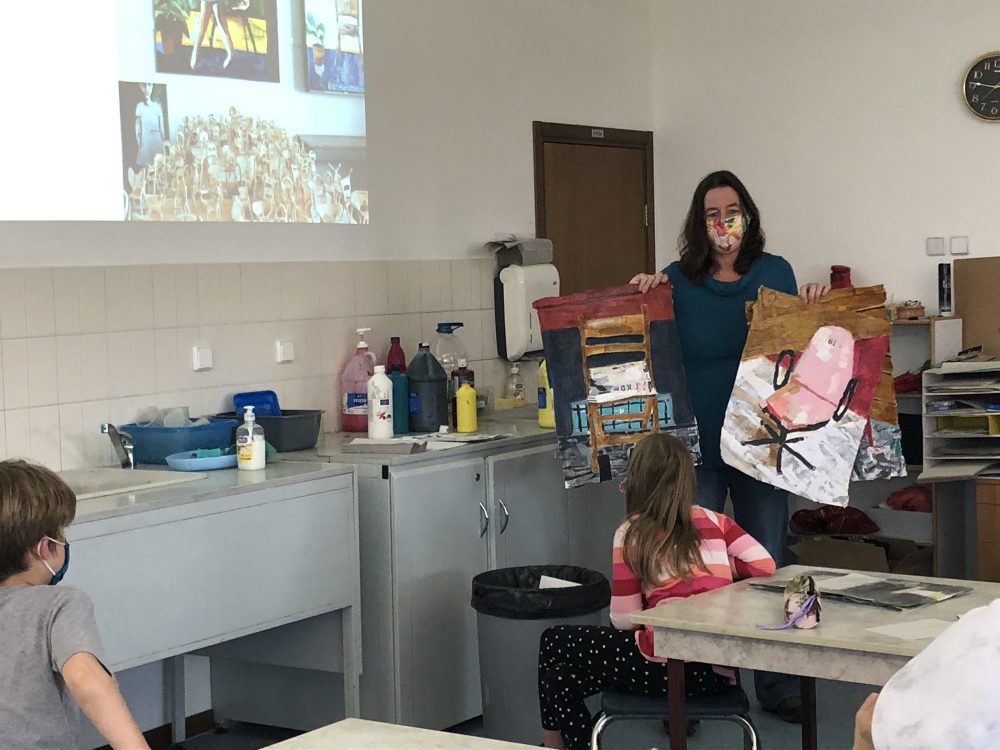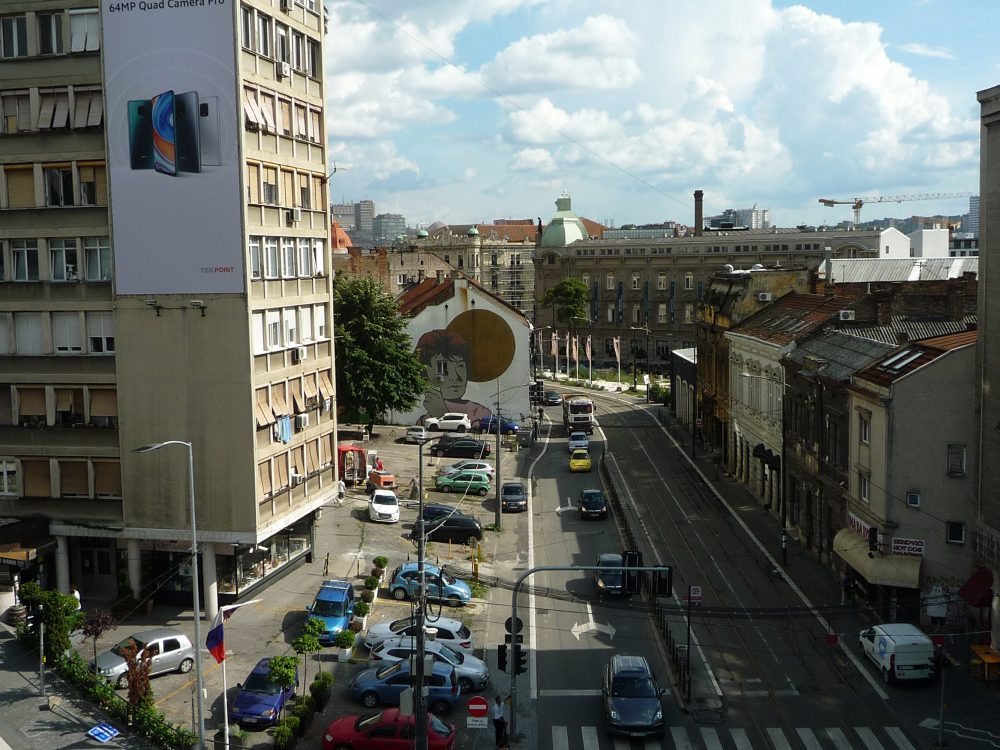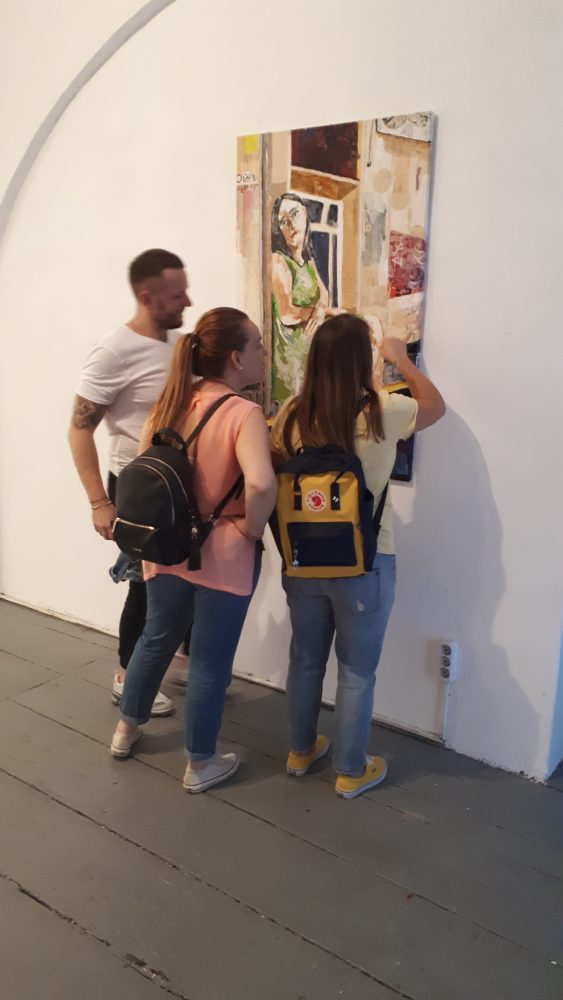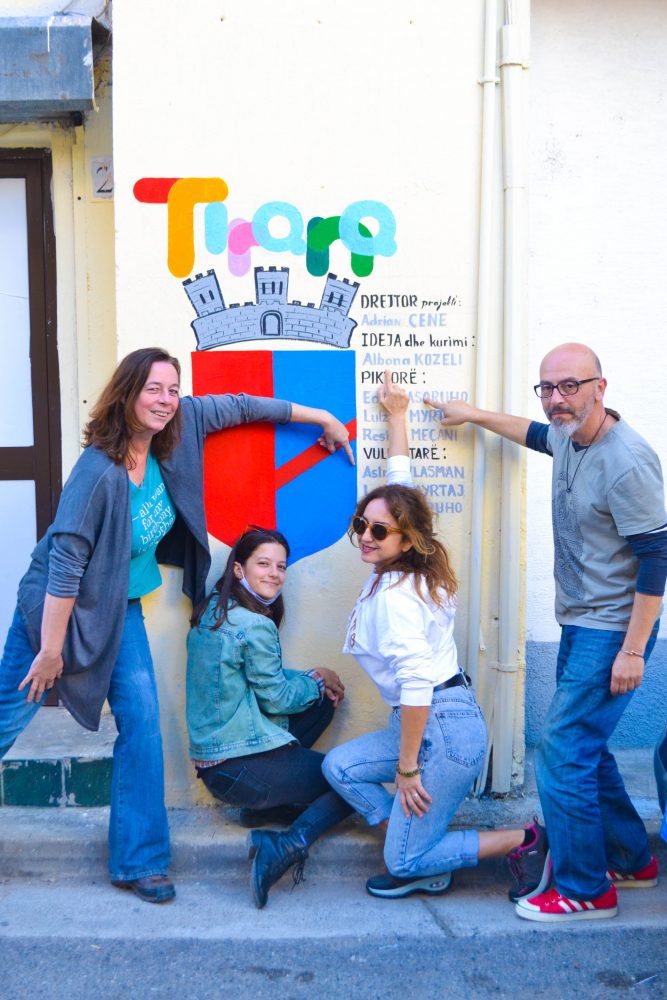With a suitcase full of old paper to the Balkans
For years Astrid Vlasman made narrative collages, but now her work consists of large canvases filled with recycled paper combined with oil paint. In her paper paintings, deserted interiors with visible human traces and women, often in uncomfortable situations or postures, look lost into the world. With a suitcase full of old paper, Astrid left early July 2020 for the Balkans for an artist-in-residence period of six months. For this she received a project subsidy from the Mondriaan Fund.

On expedition in the Balkans
I am sitting on a bench in Tašmajdan Park in the early evening. It is already dark. Around me there is the murmur of people on the other benches, runners, children riding bikes, scooters and playing ball, black-clad adolescents sitting in a huddle on a small hill with a speaker, people walking their dogs, old women bent over who are quietly shuffling past. I am in Belgrade, in the middle of summer. Life takes place here, outside in the streets. Like an explorer I take everything in. The world is full of corona but I feel free and part of this city in which I am staying for three months, half of my artist-in-residence time in the Balkans.

I have chosen the Balkans as my place of expedition; European and very close, but also complicated and unknown. Certainly Serbia is not an obvious destination for an artist. At the Belgrade Art Studio I am the first Dutch artist to work there. Serbia has a turbulent history. The country has few friends and many enemies. Just like in the neighbouring countries Albania and Bulgaria, where I will be going later on, many people have an aversion to the government and corruption. Young people want to go to the West as quickly as possible. There are no dreams and few prospects.
On the hunt for old paper
Belgrade is a busy, lively, dusty city with a messy streetscape. I feel at home right away. During endless walks I get to know the city very well. I visit museums and galleries. Many art centers are closed due to the pandemic. There are no tourists to be seen anywhere and I feel part of the city population. My studio is in Dorćol, a hip and fun neighbourhood in the centre.
I photograph all the chairs I encounter outside: this city is an inexhaustible source of inspiration
During my walks I go hunting for old paper, the material I work with. At first this is difficult, but then I find a box with old written recipes and later all kinds of school notebooks that have been thrown away at the end of the school year. Next to the theatre I fish posters out of the container. I also tear old posters from the wall. All this I use in my new work. I also take a lot of pictures of the cityscape. For the chair project I've been working on for a few years now, the city is an inexhaustible source of inspiration. I photograph all the chairs I come across on the street. When I get back, I want to work this out into a series for an installation.

Art on the street
Because the city has been bombed 44 times, the art in Belgrade is not aimed at eternity: paintings on canvas are an exception. Especially video art, performances and graphic work is exhibited, mostly by young people. The galleries are easily accessible, artists explain their work everywhere and a curator is involved in every exhibition. Yet the art is mainly visible outside on the streets in the form of murals and graffiti. Graffiti art is a full-fledged art form here. Besides tags with political statements, there are many beautiful murals to be found. From life-size to small hidden gems in all corners of the city. Here and there, even the dead are honoured with black and white murals with their faces and a date of death.
Graffiti is an art form in its own right here - from life-sized murals to little hidden gems in every corner of the city.
Exhibition in Belgrade
Over time, I meet many new people with whom, despite all the limitations, I experience cultural life. I immerse myself for two weeks in the Belgrade Documentary Film Festival, visit a classical music festival, dance in the open air to 80s music, take a bus trip to the countryside to visit an educational project. There are also many coffee dates and I take a look at the zoo. With the English-Serbian artist Mark Brogan I make future plans for a joint exhibition and with a graphic artist I make agreements about screen prints that he wants to make of my work.

At the end of my period in Belgrade, I have an exhibition at Ostavinska gallery, together with Anna Jarosz, a young Polish artist who makes an installation. I will show there my series of four paintings, the Serbian womanwhich originated in Belgrade.
Cultureclash
When I arrive in Tirana, the capital of Albania, I notice that the communist past still weighs heavily on the people here. Also the difference between rich and poor is huge. The city looks modern in some places with expensive shops where all brands are for sale, but on the other hand people try to make ends meet by selling something on the street. "Yes we are not living, we are surviving," someone tells me. The hopelessness is most tangible in this country. The man who sits on the doorstep of my studio every day making and selling bracelets, gives me his phone number because I might be able to arrange some work in the Netherlands.

Street Art
I realise that I have a luxury position in terms of time and money and decide to take up anything that comes my way and do something for others. I became involved in the Mother Theresa Street Art Project, whereby Hajar Hidi Street, a street in the centre of Tirana where Mother Theresa lived, was painted in homage. I become part of the group of local painters and do service. When I get a free hand for a mural, the cultural difference and our art history background become clear. They find my bush with flowers very strange and have to get used to it. With socialist art in mind, they take the form and the story as a starting point, while I work from expression and emotion. They had to get used to it, but in the end they were very happy with my contribution and I was allowed to paint another tree.
They take the form and the story as a starting point, while I work from expression and emotion.
Working with a group of local painters is really an addition and a good exchange between both cultures. It is also very nice to work on the street. People talk to you and tell you how much they like it. Two young ladies use my painting as a background for their posing session. But because of the reckless traffic, I have to bring myself to safety all the time. Standing on a kitchen ladder I am hit by a car after which I wobble away with a fright.
Location Sofia
My last stand is Sofia. In the Bulgarian capital I experience both autumn and winter in six weeks. I am just able to visit a few more museums before everything is locked up again for a lockdown. Fortunately I get in touch with the head of the fashion department of the art academy, and under her guidance I can see the exhibition of the last batch of students. Originally, I was supposed to have a residency at The World of Co, but they informed me back in the summer that they were cancelling the entire program because of the pandemic. The organization did refer me to a residency meant for writers and performers. Fortunately I can live and work there. I'll have to build up my contacts again from scratch, though.
In the Balkan presentation the street scene will be central and my work will be part of it.
Online art class
Mariangela Anastassova, a visual artist who teaches at the Anglo-American international school in Sofia, will be my main contact. As a guest teacher, I will be present in her classes. My chair project will be the basis of a number of lessons, in which my self-made chairs and the chairs I photographed along the way will form the inspiration for chairs that the children will make. Fortunately, I'll be able to visit the school for the first two weeks, but after that we'll have to continue online. In the end, the children made chairs from leftover materials they could find at home and we provided as many examples as we could. It is not easy to give a creative lesson from behind a computer, but I am very pleased with the inventiveness and enthusiasm of the children.
Back
Now that I'm back with all the impressions and stories, I want to make my trip visible in a Balkan presentation, where the street scene is central and my work becomes part of it. Besides my collages, I want to show photos, sounds and films. It would be nice if I could make the atmosphere of the city visible and tangible for the viewers. I look back on a wonderful adventure through which I have made lasting contacts and now feel truly connected with this region.


